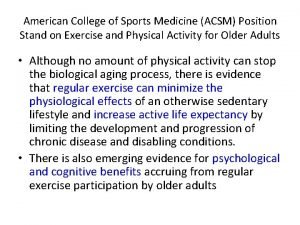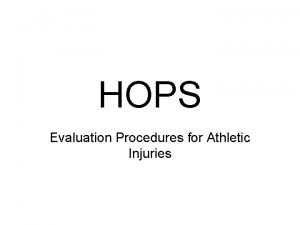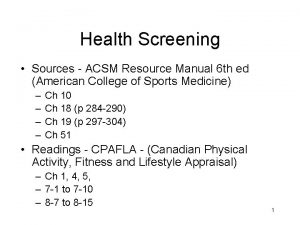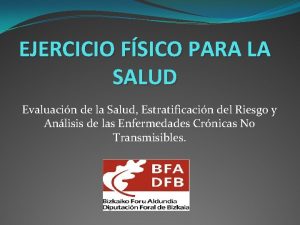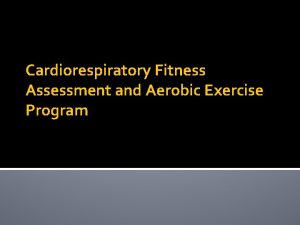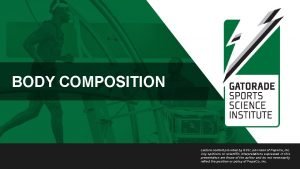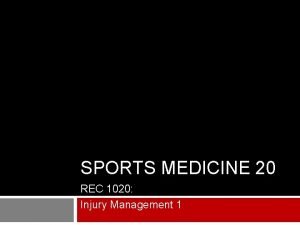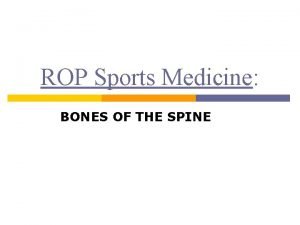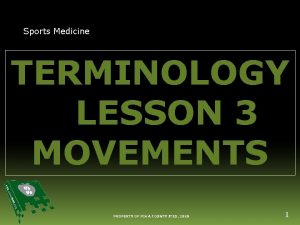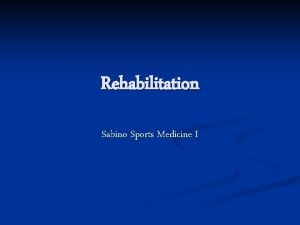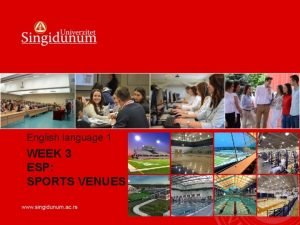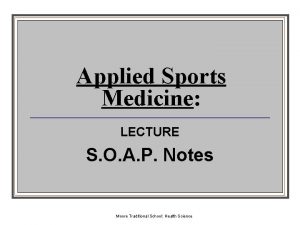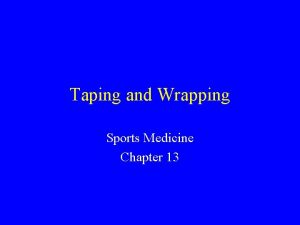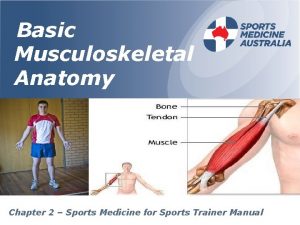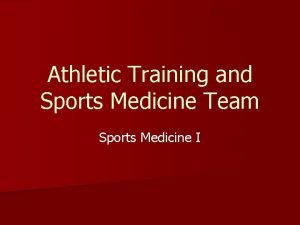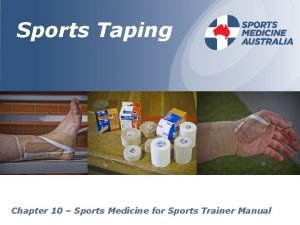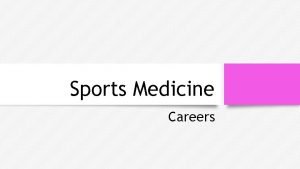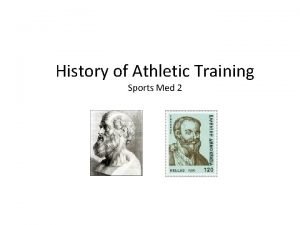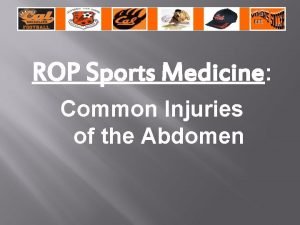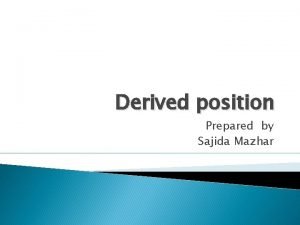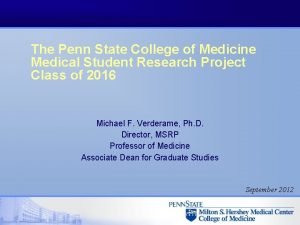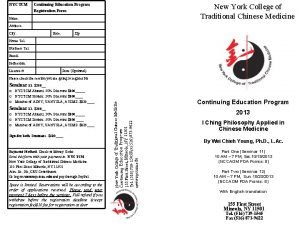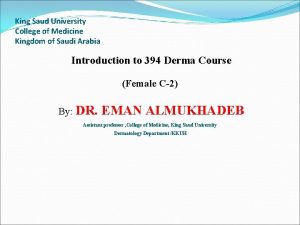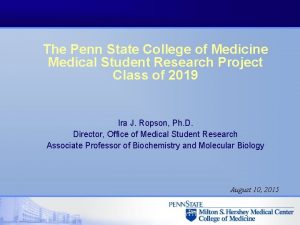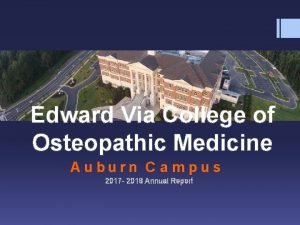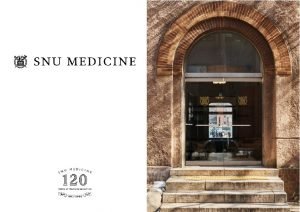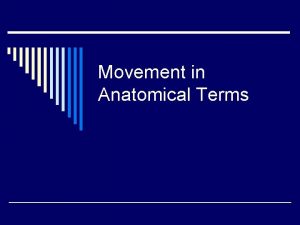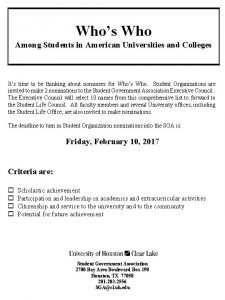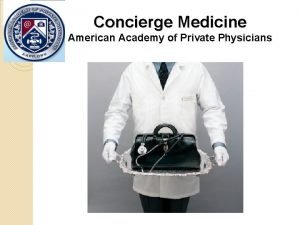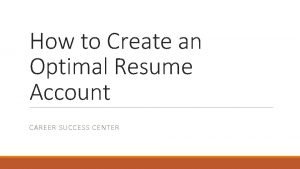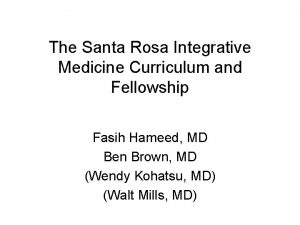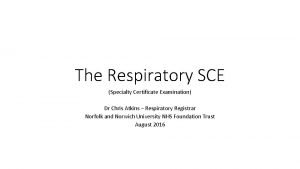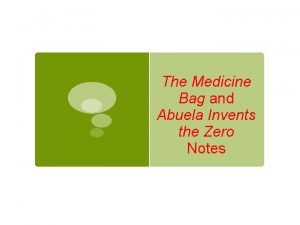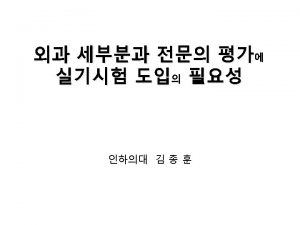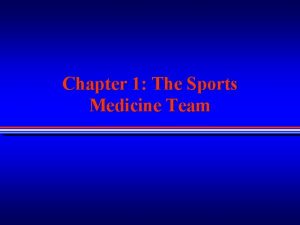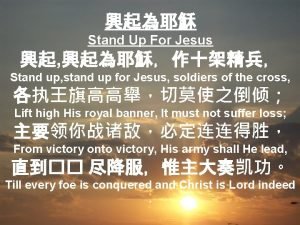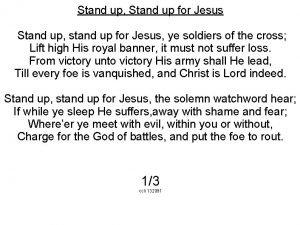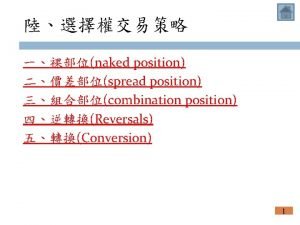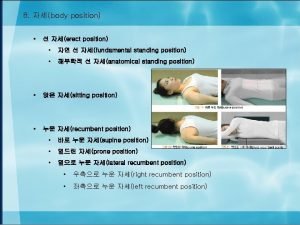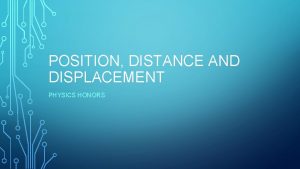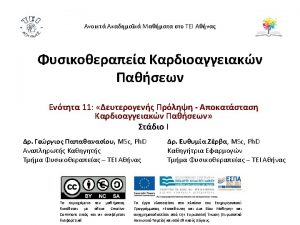American College of Sports Medicine ACSM Position Stand






























































































- Slides: 94

American College of Sports Medicine (ACSM) Position Stand on Exercise and Physical Activity for Older Adults • Although no amount of physical activity can stop the biological aging process, there is evidence that regular exercise can minimize the physiological effects of an otherwise sedentary lifestyle and increase active life expectancy by limiting the development and progression of chronic disease and disabling conditions. • There is also emerging evidence for psychological and cognitive benefits accruing from regular exercise participation by older adults

American College of Sports Medicine (ACSM) Position Stand on Exercise and Physical Activity for Older Adults • Ideally, exercise prescription for older adults should include aerobic exercise, muscle strengthening exercises, and flexibility exercises. • In addition, individuals who are at risk for falling or mobility impairment should also perform specific exercises to improve balance in addition to the other components of health-related physical fitness.

ACSM/AHA physical activity recommendations for older adults. • The ACSM/AHA recommends 150 minutes per week of physical activity for health benefits. • Additional benefits occur as the amount of physical activity increases through higher intensity, greater frequency, and/or longer duration. • If older adults cannot do 150 min of moderateintensity aerobic activity per week because of chronic conditions, they should be as physically active as their abilities and conditions allow.

Flexibility exercise for older adults: • Frequency: At least 2 days a week. Intensity: Moderate (5– 6) intensity on a scale of 0 to 10. Type: Any activities that maintain or increase flexibility using sustained stretches for each major muscle group and static rather than ballistic movements.

Flexibility training as part of an exercise program • Before beginning an Exercise Program fill out the Par. Q and follow the guidelines and recommendation given. • Before beginning the stretching exercises read the Stretching Tips pdf by Brad Walker • You could also follow Brad Walker’s “Stretching Routines for Muscle Groups” pdf.

Flexibility training as part of an exercise program • Every workout needs to be preceded by a warm-up • Timing of flexibility training depends on nature of activity during a workout

Types of flexibility training • Ballistic • Static • Proprioceptive neuromuscular facilitation (PNF) • Dynamic

Warm-up – Warm-up guidelines • Should be long enough for client to break a light sweat • Duration or intensity of warm-up needs to be increased as conditioning improves

Static Flexibility Exercises

Look Right and Left

Look Right and Left Primary Muscles Stretched Sternocleidomastoid Common Errors • 1. Stand or sit with the head • Turning the torso as the and neck upright. head turns • 2. Turn the head to the right • Not turning the head using a submaximal through the full comfortable concentric muscle action. 3. range of motion Turn the head to the left using a submaximal concentric muscle action.

Neck Flexion and Extension • Sternocleidomastoid, suboccipitals, splenae

Neck Flexion and Extension Sternocleidomastoid, suboccipitals, splenae • 1. Standing or sitting with head and neck upright, flex the neck by tucking the chin toward the chest. • 2. If the chin touches the chest, try to touch the chin lower on the chest. • 3. Extend the neck by trying to come as close as possible to touching the head to the back.

Neck Flexion and Extension Common Errors • Failing to go through a complete range of motion, either during flexion or extension • Using a jerky, explosive type of action rather than pushing against, or resisting against, the force being applied to the head; all movements should be slow, continuous, and steady • Using movements in the trunk, arms, or other parts of the body to assist in the movement at the neck; there should be no movement other than what is occurring at the neck Sternocleidomastoid, suboccipitals, splenae

Hands Behind Back Anterior deltoids, pectoralis major • 1. Stand erect and reach behind the back with both arms. • 2. Clasp the hands together and fully extend the elbows. • 3. Slightly flex the knees and look straight ahead. • 4. Raise the arms until a stretch is felt.

Hands Behind Back Anterior deltoids, pectoralis major Common Errors • Allowing the elbows to flex • Flexing the torso forward or looking down at the floor

Behind-Neck Stretch Triceps brachii, latissimus dorsi • 4. Pull the right elbow toward (and behind) the head with the left hand (i. e. , increase shoulder abduction) until a stretch is felt. 5. Repeat the stretch with the right hand grasping and pulling the left elbow.

Behind-Neck Stretch Triceps brachii, latissimus dorsi Common Errors • Flexing the torso forward or rounding the shoulders.

Pretzel Internal oblique, external oblique, piriformis, erector spinae • 1. Sit on the floor with the legs next to each other and extended away from the body. 2. With the torso upright, flex the right knee, cross it over the left leg, and place the right foot on the floor to the outside of the left knee. • 3. Twist the torso to the right to position the back of the left elbow against the outside of the right knee.

Pretzel Internal oblique, external oblique, piriformis, erector spinae • 4. Place the right palm on the floor 12 to 16 inches (30 -40 cm) behind the hips. • 5. Keeping the buttocks on the floor, use the right knee to hold the left elbow stationary while twisting the head and shoulders to the right until a stretch is felt. • 6. Repeat the stretch with the left foot placed to the outside of the right knee and the right elbow against the outside of the left knee.

Pretzel Internal oblique, external oblique, piriformis, erector spinae Common Errors • Placing the elbow on the front of the thigh (rather than to the outside of the knee) • Allowing the buttocks to rise off of the floor

Forward Lunge Iliopsoas, rectus femoris, gluteus maximus, hamstrings • 1. From a standing position, take an exaggerated step forward with the right leg. • 2. Flex the right knee until it is positioned over the right foot. • 3. Keep the right foot on the floor with both feet pointed straight ahead.

Forward Lunge Iliopsoas, rectus femoris, gluteus maximus, hamstrings • 4. Keep the left leg almost fully extended; the heel can be off the floor, if needed. • 5. Place the hands on the top of the right thigh or on the hips and look straight ahead. • 6. With the torso fully upright, move the hips forward and slightly downward until a stretch is felt

Forward Lunge Iliopsoas, rectus femoris, gluteus maximus, hamstrings • 7. Repeat the stretch with the left leg positioned ahead of the body (i. e. , lunge with the left leg).

Forward Lunge Iliopsoas, rectus femoris, gluteus maximus, hamstrings Common Errors • Allowing the lead knee to flex beyond the toes of the lead foot • Allowing the heel of the lead foot to lift off of the floor • Flexing the torso forward or looking down at the floor • Allowing an anterior pelvic tilt (forward pelvis tilt and increased low-back arch)

Lying Knee to Chest Gluteus maximus, hamstrings, erector spinae • 1. Lie supine with the legs next to each other and extended away from the body. • 2. Flex the right knee and hip to elevate the right thigh toward the chest. • 3. Grasp the back of the right thigh (underneath the right knee). • 4. Keep the left leg in the same starting position.

Lying Knee to Chest Gluteus maximus, hamstrings, erector spinae • 5. Use the arms to pull the right thigh further toward the chest until a stretch is felt. • 6. Repeat the stretch with the left knee pulled to the chest and the right leg extended away from the body.

Lying Knee to Chest Gluteus maximus, hamstrings, erector spinae Common Errors • Grasping the front of the flexed knee (rather than the back of the thigh) • Flexing the neck or arching the back • Lifting the opposite leg off of the floor

Semistraddle (Modified Hurdler’s Stretch) Hamstrings, erector spinae, gastrocnemius • 1. Sit on the floor with the right leg extended away from the body and the sole of the left foot pressed against (or near to) the inside of the right knee. • 2. The outside of the left leg will be touching or nearly touching the floor. • 3. Keeping the back flat, lean forward at the hips and grasp the toes of the right foot with the right hand.

Semistraddle (Modified Hurdler’s Stretch) Hamstrings, erector spinae, gastrocnemius • 4. Pull the toes of the right foot toward the upper body as the torso is flexed toward the right leg until a stretch is felt. • 5. Repeat the stretch with the left leg extended away from the body and the sole of the right foot pressed against (or near to) the inside of the left knee.

Semistraddle (Modified Hurdler’s Stretch) Hamstrings, erector spinae, gastrocnemius Common Errors • Allowing the extended thigh to externally rotate • Rounding the shoulders or curling the torso toward the extended leg (rather than flexing the torso at the hips) • Allowing the knee of the extended leg to flex

Butterfly Hip adductors, gracilis • 1. Sit on the floor with the torso upright. • 2. Flex the hips and knees and externally rotate thighs to bring the soles of the feet together. • 3. Lean forward at the hips and grasp the feet and move them toward the body.

Butterfly Hip adductors, gracilis • 4. Place the elbows on the inside of the legs. • 5. Keeping the back flat, slightly push the elbows down, pull the feet toward the upper body, and flex the torso forward until a stretch is felt.

Butterfly Hip adductors, gracilis Common Errors • Rounding the shoulders or curling the torso toward the feet (rather than flexing the torso at the hips)

Wall Stretch Gastrocnemius, soleus (and Achilles tendon) • 1. Stand facing a wall with the feet shoulder-width apart and the toes about 12 inches (30 cm) from the wall. • 2. Lean forward and place the hands on the wall. • 3. Step back about 2 feet (61 cm) with the left leg and slightly flex the right knee

Wall Stretch Gastrocnemius, soleus (and Achilles tendon) • 4. Fully extend the left knee and keep the left heel on the floor. • 5. Allow the elbows to flex to move the hips and torso closer to the wall until a stretch is felt. • 6. Repeat the stretch with the right leg positioned behind the body (i. e. , step back with the right leg)

Wall Stretch Gastrocnemius, soleus (and Achilles tendon) Common Errors • Moving the torso closer to the wall without also moving the hips forward • Allowing the heel of the stepped-back foot to lift off of the floor

Dynamic Flexibility Exercises

Arm Circle Deltoids, latissimus dorsi, pectoralis major • 1. While slowly walking over the prescribed distance, move the arms in wide circles, progressing from a position in which the arms are directly at the sides to a position in which the arms are directly overhead.

Arm Circle Deltoids, latissimus dorsi, pectoralis major • 2. Allow movement to occur only at the shoulder joints (i. e. , keep the elbows fully extended). • 3. Perform the arm circles both forward and backward through a full comfortable ROM.

Arm Circle Deltoids, latissimus dorsi, pectoralis major Common Errors • Allowing the torso to flex and extend as the arms move in circles

Arm Swing Latissimus dorsi, teres major, anterior and posterior deltoids, pectoralis major • 1. Flex the arms at the shoulders to position the arms parallel to the floor in front of the body. • 2. While slowly walking over the prescribed distance, swing the arms in unison to the right so the left arm is in front of the chest, the fingers of the left hand are pointing directly lateral to the right shoulder, and the right arm is behind the body

Arm Swing Latissimus dorsi, teres major, anterior and posterior deltoids, pectoralis major • 3. Immediately reverse the movement direction to swing the arms in unison to the left. • 4. Allow movement to occur only at the shoulder joints (i. e. , keep the torso and head facing forward). • 5. Alternate the arm swings to the right and left through a full comfortable ROM. Common Errors �� Allowing the torso or neck to rotate in the direction of the arm swing

Arm Swing Latissimus dorsi, teres major, anterior and posterior deltoids, pectoralis major Common Errors • Allowing the torso or neck to rotate in the direction of the arm swing

Lunge Walk Iliopsoas, rectus femoris, gluteus maximus, hamstrings • 1. Clasp the hands behind the head. • 2. From a standing position, take an exaggerated step forward with the left leg. • 3. Flex the left knee until it is positioned over the left foot. • 4. Slightly flex the right knee to be just off the floor; both feet should be pointed straight ahead

Lunge Walk Iliopsoas, rectus femoris, gluteus maximus, hamstrings • 5. Keep the torso erect (or leaning back slightly) and look straight ahead. • 6. Pause for a count in the bottom lunged position, stand up, and then repeat with the right leg, progressing forward with each step.

Lunge Walk Iliopsoas, rectus femoris, gluteus maximus, hamstrings Common Errors • Allowing the lead knee to flex beyond the toes of the lead foot • Touching the knee of the trailing leg to the floor • Flexing the torso forward or looking down at the floor

Body Weight Exercises

Resistance exercise for older adults: • Frequency: At least 2 days a week. Intensity: Between moderate- (5– 6) and vigorous- (7– 8) intensity on a scale of 0 to 10. Type: Progressive weight training program or weight bearing calisthenics (8– 10 exercises involving the major muscle groups of 8– 12 repetitions each), stair climbing, and other strengthening activities that use the major muscle groups.

Abdominal Crunch Level 1

Abdominal Crunch Level 2

Abdominal Crunch Level 3

Abdominal Crunch Rectus abdominis • 1. Assume a supine position on the floor. • 2. Flex the hips and knees and place the heels on a box. • 3. Place the hands behind or at the sides of the head (to hold its weight only) or fold the arms across the chest or abdomen.

Abdominal Crunch Rectus abdominis • 4. Curl the torso until the upper back is off of the floor. Client should maintain a tucked or neutral head and neck position. • 5. Keep the feet, buttocks, and lower back stationary at all times. • 6. After completing the crunch, allow the torso to uncurl back down to the starting position.

Abdominal Crunch Rectus abdominis Common Errors • Raising the hips or feet • Pulling the head with the hands • Flexing the torso to a fully seated position

Variation: Twisting Crunch Rectus abdominis, internal and external oblique • 1. Assume a supine position on the floor. • 2. Flex the hips and knees and place the heels on a box or bench. • 3. Place the hands behind or at the sides of the head (to hold its weight only) or fold the arms across the chest or abdomen.

Variation: Twisting Crunch Rectus abdominis, internal and external oblique • 4. Twist (rotate) the torso to move the right shoulder toward the left thigh. • 5. Continue flexing and twisting the torso until the upper back is off of the floor. • 6. Keep the feet, buttocks, and lower back stationary at all times.

Variation: Twisting Crunch Rectus abdominis, internal and external oblique • 7. After completing the crunch, allow the torso to uncurl and untwist back down to the starting position. • 8. Alternate the direction of the twist with each repetition.

Variation: Twisting Crunch Rectus abdominis, internal and external oblique Common Errors • Raising the hips or feet • Pulling the head with the hands

Back Extension Level 1 Erector spinae

Back Extension Level 2 Erector spinae • 1. Assume a prone position on the floor with the knees fully extended and the toes pointed down to the floor. • 2. Clasp the hands behind the head.

Back Extension Erector spinae • 3. Keeping the toes in contact with the floor, extend the torso (i. e. , arch the back) to lift the chest off the floor. • 4. After completing the extension, allow the chest to lower and return to the starting position.

Back Extension Erector spinae Common Errors • Flexing the knees or lifting the toes off the floor • Rapidly rocking up and down on the hips (rather than performing the movement under control)

Variation: Twisting Back Extension Erector spinae • 1. Assume a prone position on the floor with the knees fully extended and the toes pointed down to the floor. • 2. Clasp the hands behind the head. • 3. Keep the toes in contact with the floor. • 4. Extend and twist (rotate) the torso to move the right shoulder up and to the left.

Variation: Twisting Back Extension Erector spinae • 5. Continue extending and twisting the torso until the chest is off of the floor. • 6. Keep the feet, buttocks, and lower back on the floor at all times. • 7. After completing the extension, allow the chest to lower and untwist back down to the starting position. • 8. Alternate the direction of the twist with each repetition.

Variation: Twisting Back Extension Erector spinae Common Errors • Flexing the knees or lifting the toes off the floor • Rapidly rocking back and forth on the hips (rather than performing the movement under control)

Push-Up • Pectoralis major, anterior deltoid, triceps brachii

Push-Up Pectoralis major, anterior deltoid, triceps brachii • 1. Assume a prone position on the floor with the knees fully extended and the toes pointed down to the floor. • 2. Place the hands on the floor, palms down, about 2 to 3 inches (5 -8 cm) wider than shoulder-width apart with the elbows pointed outward

Push-Up Pectoralis major, anterior deltoid, triceps brachii • 3. Keeping the body in a straight line and the toes in contact with the floor, push against the floor with the hands to fully extend the elbows. • 4. After completing the push-up, lower the body by allowing the elbows to flex to a 90° angle. Alternatively, the personal trainer can place a soft object about the size of rolled-up socks or a foam half-roller on the floor beneath the client’s chest and count the repetitions only when the client’s chest touches the socks or roller.

Push-Up Pectoralis major, anterior deltoid, triceps brachii Common Errors • Allowing the hips to sag or rise up (rather than keeping the body in a straight line) • Performing the exercise through a reduced ROM

Modified Push-Up Pectoralis major, anterior deltoid, triceps brachii

Variation: Modified Push-Up Pectoralis major, anterior deltoid, triceps brachii • 1. Modify the standard push -up technique by having the client assume a kneeling position, with the knees flexed to 90° and the ankles crossed.

Variation: Modified Push-Up Pectoralis major, anterior deltoid, triceps brachii Common Errors • Allowing the hips to sag or rise up (rather than keeping the body in a straight line) • Performing the exercise through a reduced ROM

Variation: Inclined Push-Up

Variation: Standing Wall Push-Up

Chair Squats

Assisted Chair Squats

Chair Assisted Squats

Air Squats • The Air Squat - You. Tube

Air Squats

One legged Chair Squats

Hip Flexors

Sitting Hip Flexors

Standing Hip Flexors

Heel Raise • Gastrocnemius, soleus

Sitting Heel Raises

Endurance exercise for older adults: • Frequency: For moderate-intensity activities, accumulate at least 30 or up to 60 (for greater benefit) minutes per day in bouts of at least 10 min each to total 150– 300 minutes per week, • At least 20– 30 minutes per day or more of vigorousintensity activities to total 75– 150 minutes per week, an equivalent combination of moderate and vigorous activity. • Intensity: On a scale of 0 to 10 for level of physical exertion, 5 to 6 for moderate-intensity and 7 to 8 for vigorous intensity.

Endurance exercise for older adults: • Duration: For moderate-intensity activities, accumulate at least 30 minutes per day in bouts of at least 10 min each or at least 20 minutes per day of continuous activity for vigorous-intensity activities. • Type: Any modality that does not impose excessive orthopedic stress; walking is the most common type of activity. Aquatic exercise and stationary cycle exercise may be advantageous for those with limited tolerance for weight bearing activity.

In Place Walking

In Place Walking Stage 1 Normal walking

In Place Walking Stage 2 Medium Arm Swing and High Knee

In Place Walking Stage 3 Big Arm Swing, Knees to the Hips

In Place Walking Stage 4 Big Arm Swing, Knees above the Hip

In Place Walking Stage 5 Big Arm Swing, Knees above the Hip, and Getting up on Toes (Do not leave the floor)
 Splenae
Splenae Hops evaluation
Hops evaluation Second position
Second position Acsm 2014
Acsm 2014 Acsm risk factors
Acsm risk factors Ecnts
Ecnts Absolute contraindications to exercise testing
Absolute contraindications to exercise testing Acsm body fat chart
Acsm body fat chart Smart goals acsm
Smart goals acsm Acsm risk stratification
Acsm risk stratification Acsm role
Acsm role Sports medicine definition
Sports medicine definition Rop sports medicine
Rop sports medicine Hops evaluation example
Hops evaluation example Healthcare and the healthcare team chapter 2
Healthcare and the healthcare team chapter 2 Sports medicine terminology
Sports medicine terminology Meditouch sports medicine
Meditouch sports medicine Esp sports medicine
Esp sports medicine Flexion vs extension
Flexion vs extension Soap sports medicine
Soap sports medicine Athletic training taping techniques
Athletic training taping techniques Scope of sports medicine
Scope of sports medicine Sports medicine team project
Sports medicine team project Chapter 2 sports medicine
Chapter 2 sports medicine Sports med umbrella
Sports med umbrella Sports medicine team definition
Sports medicine team definition Chapter 8 worksheet bandaging and taping
Chapter 8 worksheet bandaging and taping Sports medicine careers
Sports medicine careers Objective of sports medicine
Objective of sports medicine Athletic training sports medicine
Athletic training sports medicine Rop sports medicine
Rop sports medicine Meditouch israel
Meditouch israel How do you find these activities
How do you find these activities Stand up for jesus
Stand up for jesus Come on everybody stand up stand stamp your feet
Come on everybody stand up stand stamp your feet Medical term for standing
Medical term for standing Medicine wheel colors
Medicine wheel colors American board of cardiovascular medicine
American board of cardiovascular medicine American academy of physical medicine and rehabilitation
American academy of physical medicine and rehabilitation Yard standing
Yard standing Penn state college of medicine msr
Penn state college of medicine msr New york college of traditional chinese medicine
New york college of traditional chinese medicine Lincoln memorial university college of veterinary medicine
Lincoln memorial university college of veterinary medicine King saud university college of medicine
King saud university college of medicine King saud university college of medicine
King saud university college of medicine Prodofol
Prodofol Penn state college of medicine msr
Penn state college of medicine msr King saud university college of medicine
King saud university college of medicine Vcom mission statement
Vcom mission statement Al mustansiriya university college of medicine
Al mustansiriya university college of medicine Dr courtney mapes
Dr courtney mapes Midwestern university college of dental medicine
Midwestern university college of dental medicine Seoul national university history
Seoul national university history Ukcom curriculum
Ukcom curriculum Touro college of medicine new york
Touro college of medicine new york Baylor college of medicine academy at ryan
Baylor college of medicine academy at ryan Texas college of osteopathic medicine
Texas college of osteopathic medicine Fundamental position vs anatomical position
Fundamental position vs anatomical position Position fundamental
Position fundamental Rib raising omt
Rib raising omt Who's who among american college students
Who's who among american college students American association of private physicians
American association of private physicians American career college optimal resume
American career college optimal resume Asd college college readiness program
Asd college college readiness program Early college high school at midland college
Early college high school at midland college Who traditional medicine strategy 2014-2023
Who traditional medicine strategy 2014-2023 Lt lead time
Lt lead time University of medicine and pharmacy timisoara
University of medicine and pharmacy timisoara Intranet venus
Intranet venus Polynomials in healthcare
Polynomials in healthcare Unm internal medicine residency
Unm internal medicine residency Umass surgery residents
Umass surgery residents Typhoid medicine course
Typhoid medicine course Total internal reflection in medicine
Total internal reflection in medicine Types of family in community medicine
Types of family in community medicine Integrative medical clinic santa rosa
Integrative medical clinic santa rosa Acute medicine sce pass mark
Acute medicine sce pass mark The medicine bag plot diagram
The medicine bag plot diagram Hubert kairuki memorial university faculty of medicine
Hubert kairuki memorial university faculty of medicine Timetable upjs
Timetable upjs The father of modern medicine
The father of modern medicine Hyperparathyreosis
Hyperparathyreosis Concept of lead time
Concept of lead time Objectives of school health programme
Objectives of school health programme Siddha system of medicine
Siddha system of medicine Medical
Medical Leicester precision medicine institute
Leicester precision medicine institute Dr rubina yasmin
Dr rubina yasmin Principles of family medicine
Principles of family medicine Halifax family medicine residency
Halifax family medicine residency Application of optical fiber
Application of optical fiber Afrodizzia medicine
Afrodizzia medicine Monash public health
Monash public health Meritus family medicine
Meritus family medicine Family medicine fellowships
Family medicine fellowships
